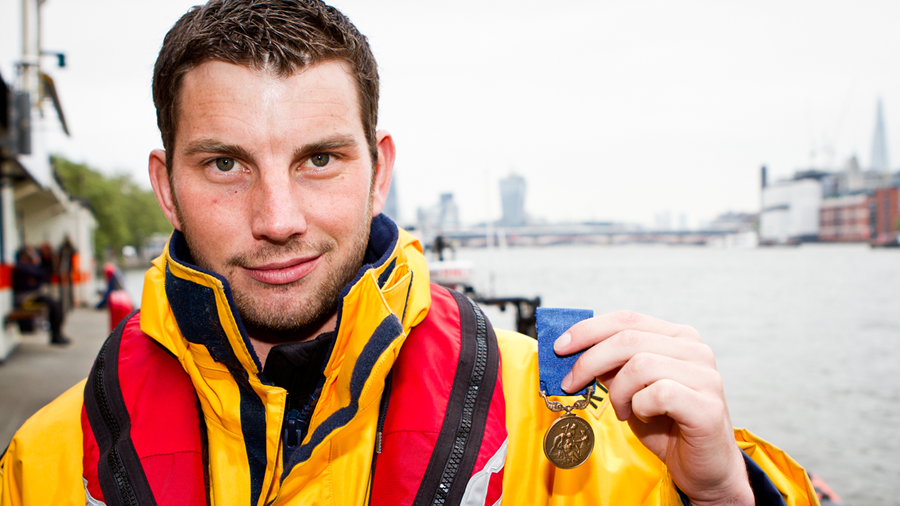

The Foremost rescue: A story of immense bravery
It’s 1940, and the crew at Arbroath RNLI have launched to help a hopper barge in distress. But there’s an unexpected interruption during their rescue mission …
9 February 1940, 10.35am.
Arbroath, Angus, the east coast of Scotland.Distress signals are heard off the coast of Arbroath. The local volunteers gather and quickly launch their self-righting motor lifeboat, John and William Mudie. It’s a hazy day but the Arbroath RNLI crew power on. Six miles into their journey, they see two minesweepers – small warships that remove or detonate naval mines. Just beyond the minesweepers is a 59m hopper barge from Aberdeen called Foremost 102, designed to transport bulk materials like sand, coal or steel.
Foremost is stationary in the water. The lifeboat heads towards it, to see if its crew needs help.
The lifeboat volunteers are just a quarter of a mile away when two German bombers appear from the mist. They pass just 8ft above the lifeboat and begin attacking the barge with bombs and machine guns.
The nearby minesweepers immediately open fire on the bombers. This puts the lifeboat under fire from the German planes and the minesweepers. Undeterred, the brave crew continue towards the barge.
Suddenly, ten bombs fall from above, dropping perilously close to the lifeboat. According to the crew, the explosion ‘seemed to lift the lifeboat out of the water and made all the air-cases inside her rattle’.
The lifeboat still holds on.
Then a British fighter plane appears and drives the bombers off. Miraculously, neither the hopper barge nor the lifeboat have been hit.
The lifeboat finally reaches the barge. Foremost had left port with a crew of nine but had previously been bombed, which killed two of their men. The lifeboat rescues the remaining seven crew and brings them safely ashore.
‘Gallant performance’
To recognise the heroic rescue, Queen Elizabeth The Queen Mother sends a message of congratulations to Coxswain William Swankie and his crew. The letter reads:
‘The Queen has heard with great interest of the fortitude displayed by the crew of the Arbroath lifeboat who put out recently, undeterred by their lack of defence, to the aid of a dredger which was being attacked by a German bomber.
‘Her Majesty well remembers launching the life-boat at Arbroath, and whilst it is no surprise to learn of the gallantry of her fellow-countrymen, she would be glad if you would convey to Mr. William Swankie and all his crew her congratulations on their gallant performance.’
The Queen Mother had visited Arbroath RNLI in 1932 to name John and William Mudie, the station’s first motor lifeboat.
Coxswain William Swankie is awarded the Bronze Medal for Gallantry. The six members of his crew, Second Coxswain David Bruce, Bowman Robert Cargill, Motor Mechanic Harry Swankie, and Crew Members William Scott, Joseph Cargill and Charles Smith, all receive the Thanks of the Institution Inscribed on Vellum.
Coxswain Swankie is also awarded the British Empire Medal for his bravery and meritorious service.
RNLI volunteers played a remarkable role in the Second World War, saving lives at sea in exceptionally dangerous conditions.
Lifeboat crews weren’t just launching to the rescue of shipwrecked sailors during this time – they were towing vessels loaded with explosives and top-secret information, navigating minefields, rescuing downed aircrew, ferrying food to remote villages, bringing doctors to the injured and taking priests to the dying.
Over the course of the war, and excluding those saved at Dunkirk, RNLI lifeboat crews saved 6,376 lives.
Through peace and war, our volunteers have always been ready to save lives – powered by courage, determination, and the support of kind people like you.
More stories of courage
We’d love to hear more about those who played a role in RNLI rescues during the Second World War, from the Home Front to the front line.
If you have stories or photos of our lifeboat crews – or those they rescued – you can share them on our RNLI Stories of Courage 1939-45 online portal. This is a unique opportunity to gather and preserve stories that might otherwise be lost.
This project was made possible with The National Lottery Heritage Fund, with thanks to National Lottery players.
You may also enjoy the following









